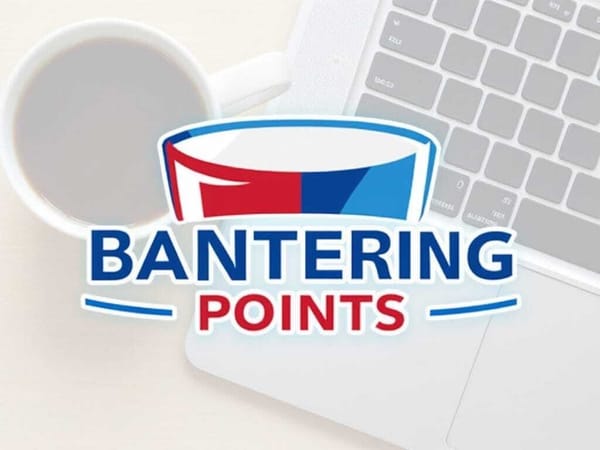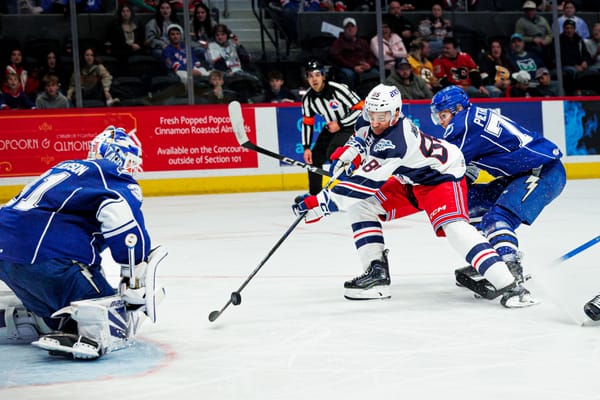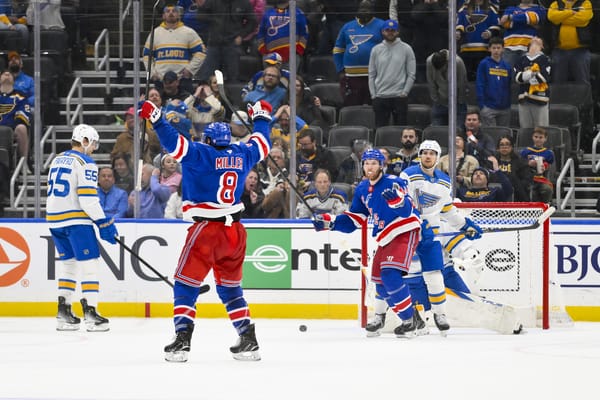Rangers’ Can’t Kick D-Can Down the Road Next Season
With room needed to grow, bringing back Adam McQuaid will hurt more than it helps
It’s entirely possible, even likely, that Brady Skjei and his teammates feel more comfortable when Adam McQuaid is on the ice. The rugged veteran has carved out a reputation around the league as a quality, no-nonsense type player who is first into every scrum and has no issue dropping his gloves in defense of his teammates.
But despite the quickly changing nature of today’s NHL that’s tilted front office desires toward speed and skill over brute strength and toughness, facts are facts. The New York Rangers aren’t a good team, and players like McQuaid have trade value that the team can’t really afford to pass up on.
Unsurprisingly, Skjei and head coach David Quinn have both been vocally supportive of McQuaid’s presence at numerous points during this season, most recently after the Rangers’ practiced this past Monday:
”[McQuaid’s] done a lot of great things,” Quinn told the New York Post after his group’s scrimmage ahead of their Tuesday night contest with the Winnipeg Jets. “Him and Brady have really played well together. I think Brady Skjei has by far played his best hockey of this year. Obviously I wasn’t here his first two years, but boy, he’s defending hard.”
”I think Adam’s had something to do with that, but I also think one of the reasons Adam’s playing well is because he’s playing with Brady. I think they’ve both fed off each other,” Quinn went on to say of McQuaid’s influence on Skjei of late.
Of course, the pesky facts aren’t exactly analogous with Quinn’s narrative, particularly regarding McQuaid, who ranks last among Rangers’ defenders this season in both 5-on-5 Corsi (43.43 percent) and relative Corsi (-5.07). When narrowing down to just unblocked attempts and looking at his Fenwick, his 45.2 percent is tied with Skjei for the third-worst of the team. For some context, those numbers have been accumulated under a moderately defensive-heavy zone start differential that’s seen him take roughly 60% of his starts in his own end.
My colleague, Tom Urtz Jr, broke down much of the data countering this narrative back in mid-January when, again, Quinn asserted the benefit of McQuaid’s presence relative to Skjei. Suffice it to say, the numbers didn’t support the claim then, and still don’t now. Though there’s something to be said of the mental aspect here — one that in spite of running against the math, might speak to an immeasurable sense of comfort created by McQuaid’s presence.
There’s also the public relations factor to consider — one not lost on Tom, who also noted that talk of McQuaid as a a “steadying force” would likely aid the Rangers in eventually selling him to another team at the deadline. Granted, teams rarely disparage their own players, but in McQuaid’s case, it’s not all that difficult to buy the argument that the Rangers’ PR machine has been putting in the extra work on selling McQuaid’s presence this season since they don’t have much to work with stats-wise. Either that, or they genuinely do believe in him, which only further puts how they evaluate defensemen into question.
Of course, this story is only a microcosm of the greater issue that is the general state of the Rangers’ defensive group, but it’s also one that’s since been compounded following remarks made by TSN’s Darren Dreger on Toronto’s TSN 1050 radio yesterday.
While on site in Winnipeg, Dreger made reference to a likelihood that McQuaid would be traded — an unsurprising sentiment given his free agent status and the position the Rangers have found themselves in this season. But when he was pressed on if he thought the Toronto Maple Leafs would have any interest in trading for McQuaid, Dreger took things a step further:
”I can’t say they wouldn’t,” said Dreger. “He’s a character guy. I know the Rangers like him a lot. In fact, I wouldn’t be surprised if he gets traded and then potentially signs back with the Rangers in the off-season.”
Talk about a record-scratch moment.
Whether or not McQuaid makes any sense for the going-for-it Leafs is questionable. They do appear in the market for a right-handed defenseman, and stranger things have happened, but McQuaid seems an ill fit for a club as high-flying and skill-oriented as they are. More importantly, buried in the lede, is the question of whether McQuaid has any business being brought back to New York this summer.
Beyond the specious logic regarding his on-ice influence on Skjei, McQuaid’s tenure as a Ranger is probably best characterized by the logjam his acquisition created in the first place. One the Rangers’ front office has surprisingly allowed to continue to the tune of eight roster defenseman all season long.
While the Rangers had the right idea in terms of the culture value he’d bring, they seemingly underestimated the complications bringing McQuaid in as late as they did would produce. The team already had more NHL defenders than it knew what to do with. It was untenable in October, and little has changed since but for the loss of Fredrik Claesson to a shoulder injury that’s temporarily alleviated an unnecessary problem they made for themselves.
If the Rangers are seriously considering bringing the 32-year-old back for an encore season on Broadway, it’s going to require major blue line reconstructive surgery lest the team find themselves in the same situation they’ve been in all year. And this says nothing of the message it would send to a pair of 21-year-old defenders in Ryan Lindgren and Libor Hajek, who would effectively see themselves boxed out before they have an honest chance to fight for a roster spot in camp next fall.
This re-McQuaid. I'll remind everyone that the Rangers are already overloaded on defense, so unless you're removing one of Pionk/DeAngelo/Smith, and admitting Lindgren/Hajek aren't going to be good enough for a full time role next year, this doesn't make sense to me https://t.co/plHiqP5eEt
— Joe Fortunato (@JoeFortunatoBSB) February 12, 2019
If the Rangers were somehow able to make major changes to their defense between now and then, it’s a little bit easier to accept the idea of a return ticket extended McQuaid’s way this July. But that change is unlikely to occur where it needs to most.
With trade protection and big cap hits anchoring the likes of Brendan Smith, Marc Staal, and Kevin Shattenkirk to the Rangers’ immediate future, it’s far more likely that entertaining the idea of bringing McQuaid back would come at the direct expense of at least one of Claesson, or Tony DeAngelo, if not both; the optics of which would be undeniably poor.
In McQuaid’s case, it’s probably true that he’s been a model citizen and a calming presence in the Rangers’ dressing room during his time here. But neither negates his negative on-ice impact in most games, nor vindicates the front office’s decision to carry an unworkable number of defenders as long as they already have. Repeating this sequence would be mind-boggling.
No, rather, the simplest, safest, and most rewarding path forward should see the Rangers’ continued pumping of McQuaid’s tires via this PR machine as a prelude to flipping him to a contending team for the best return possible. Upon thanking him for his service on the way out, the next logical step would be continuing their rebuild without him.
There are still a number of fish left to fry — both big and small — in improving New York’s blue line over the next number of seasons. Ones in which the pressure to improve is only going to increase year-over-year as up-and-coming prospects vie for starring roles. As this year has no doubt taught them, carrying a plethora of veteran defenders can only stall that progress. That’s tenable so long as those youngsters continue their development at lower levels, but it becomes instantly problematic the moment they’re ready for more.
While the Rangers can’t yet be certain they have the in-house answers to their long-term defensive problems, they can at least be certain that they’re not superfluously blocking potential solutions with an endless array of stopgaps. And, barring an unlikely high turnover percentage on their current blue line, that’s exactly what a return ticket for McQuaid would represent.
Data via Corsica.hockey, collected prior to Tuesday’s game versus Winnipeg.





